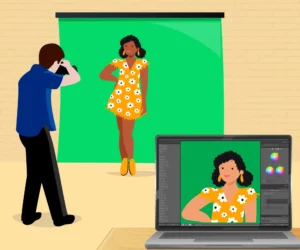
Whatever size you are, you’ve probably had people make fun of you. “How’s the air up there?” they’ll ask or make snarky remarks like “men don’t like just skin and bones.” Instead of salutations, relatives will ask about your weight. Discrimination based on size, weight, and height can cost people jobs, opportunities, and everyday privileges. Prejudices abound on both sides: fat people are lazy, while thin people are anorexic. When it comes to the female body, all of these prejudices become amplified. Representations of the fat body take on many forms—from TikTok fat acceptance videos to romcom funny fat friends, with numerous instances of body shaming and body positivity. Let’s explore.
Body shaming is not the way to body positivity
Body positivity naysayers like Bill Burr and Bill Maher believe that overweight individuals will not get healthier unless they feel shame regarding their bodies. So they season their standup comedy with staggering advice such as ‘Lay off the doughnuts!’. However, as James Corden pointed out, and any fat person will attest, if body-shaming led to weight loss, we’d all be thin by now.
As a fat person, I’m well aware that people would prefer that I starve rather than continue being fat. This understanding is so deeply ingrained that trying to love myself sometimes feels like a farce. When content creators speak about body positivity and being happy in your own skin, it can feel like you are striving towards a false ideal after being conditioned throughout life to hate your body. The amount of importance placed on one’s appearance is ironic. So many TikTok body positivity accounts have devolved into records of the creator’s hypocrisy regarding their body. When their weight starts to cause serious health problems, these individuals resort to bariatric surgery and other procedures. Fat acceptance has become a joke, with people promoting unhealthy lifestyles and eating habits and lying about their after-effects.
Much more responsibly, platforms like ‘I Weigh’ promote body acceptance. The platform encourages people to get out of the diet culture mindset and approach exercise with joy rather than as self-punishment. The body neutrality they advocate is more realistic, consisting of our multifaceted emotions regarding our bodies. They also create the space for people to go beyond body identity and find other ways of defining themselves.
Body shaming tropes masquerading as body positivity
The bodies we see onscreen have never been more unrealistic—from contoured make-up to filters projecting an unattainable image. When the Kardashians apply filters to pictures of their already surgically enhanced bodies, they are both governed by the market and creating it. Today’s ideal body tries to mimic some video game or anime character.
Slender bodies still occupy much of the foreground in movies and TV shows. It’s not just that there aren’t any fat protagonists, but the representation is often negative, favouring colourism and featurism. Indian movies are chock-full of fat-phobic jokes, whether it’s Bollywood’s Ajay Devgn running away from a fat girl in Ho Nahi Sakta or the entire character of Tsunami Singh in Bodyguard. The theme ‘a fat person is a repulsive monster’ has been so overused that both are now synonymous.
When I was growing up, there wasn’t much representation at all. For example, Bridget Jones was supposed to be a fat and single woman. Still, the gorgeous Renée Zellweger played the role. Also, the chubby fat girl in Love Actually is NOT actually fat! To top it all off, there were too many fat suits. Just think back to every Eddie Murphy movie where he played multiple characters, to Fat Monica from Friends and Gwyneth Paltrow in Shallow Hal. The only fat people one saw were thin folk in stuffy costumes. In Paltrow’s case, the actress stated that she was treated very differently in the fat suit than otherwise. She called the experience “so sad, so disturbing”.
On the other shore of body shaming
Comparatively, life on the good-looking side is a paradise. ‘Pretty privilege’ comes to the aid of the attractive. This concept stems from the idea that pretty people get amenities and opportunities not afforded to those who don’t fit into traditional beauty norms. Pretty privilege also has to do with other forms of privilege that precede it. It all boils down to what is considered ‘pretty’. Often, the way it goes is this: the closer your features and body are to Eurocentric beauty standards, the prettier you must be. In Norbit, for instance, the titular character’s wife is fat, mean, loud and undesirable—the only way she could get a man to love her is through brute force. Meanwhile, his childhood sweetheart is a very slender, light-skinned, ‘pretty’ woman.
Of course, each culture has its own idea of beauty. Nevertheless, when different cultures interact, these ideals collide and sometimes become very convoluted. K-pop bodies, for instance, are all 50 kgs or less. Whether this is due to genetics, a diet rich in vegetables, or unhealthy crash diets, many may find this kind of body unattainable.
The funny fat friend
The fat chick in movies is the pretty girl’s friend—someone who doesn’t have a life of her own and, most often, just wants to see her slimmer friend happy. She is quirky, funny, quick-witted, and unthreatening. Like the main character from Kabir Singh says in that cringe-worthy line, “fat girls and pretty girls go well together”. Lines like this assume that a fat girl cannot simultaneously be attractive. Additionally, it implies that for female friendships to work, one of the girls should be unthreatening, the premise being that women must always be competing with each other. The Fat Amys of the movie world are good for a laugh but not for the lead. The fat girl does not deserve love unless you hit your head, and her inner beauty, i.e. skinniness, is exposed to your eyes alone (like in Shallow Hal).
Get it right!
We need more characters that are confident in their own skin, like Donna Meagle from Parks and Recreation, Po from Kung Fu Panda, or Olive from Little Miss Sunshine. We also need flawed, vile, complex, and well-rounded characters of all shapes and sizes. There are so many interesting stories and different kinds of bodies to appreciate beyond mere tokenism. As for the real world, the body acceptance movement is not anyone’s vehicle to promote irresponsible lifestyles. Instead, it serves as a reminder to love your body enough to take care of it, to be kind to it, and to believe that its dignity deserves respect.


